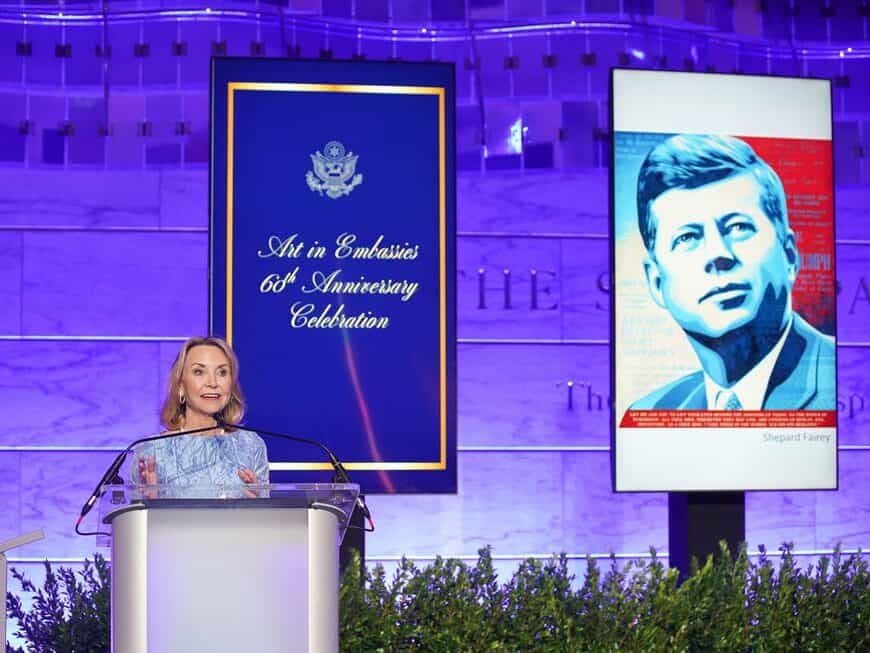The Diplomat’s new season uncovers ambassador Kate Wyler’s challenges, both in her career and personal life. Yet, as viewers tune in, it leaves many wondering just how accurately the series reflects real diplomatic practices. One scene, in particular, raises eyebrows: the fictionalized U.S. ambassador’s residence in London, where art is a secondary thought. This couldn’t be further from the truth.

PROJECT OVERVIEW
Design: Art in Embassies
Location: U.S. Embassy, London
Director: Megan Beyer
Art: Ellsworth Kelly, Cecily Brown, Didier William
Photography: Department of State, Embassy Staff
Ambassador: Various Locations Worldwide
Behind the scenes, a little-known government office ensures that these diplomatic spaces reflect more than just personal tastes—the Department of State’s Art in Embassies program. Contrary to the show’s portrayal, ambassadors aren’t left to decorate with whatever’s left in the storeroom. Instead, this program plays a critical role in aligning art with diplomatic missions.

Established over six decades ago, Art in Embassies was first conceptualized by the Museum of Modern Art in 1953 and later formalized by President Kennedy in 1963. Today, it operates in more than 200 diplomatic facilities worldwide, embedding art as a tool of soft power. Megan Beyer, the current director, leads the charge with about 60 exhibitions per year. Her appointment, like those before her, was influenced by her alignment with the values of the sitting administration—a practice that underscores the office’s political ties.

“It’s famously an office that people don’t know exists,” Beyer says, reflecting on her unusual but impactful role. She recalls how art in embassies often does more than beautify spaces; it represents America’s story in a relatable way. When her husband served as ambassador to Switzerland, paintings of the Appalachian Trail in their residence served as conversation starters, subtly aligning personal experiences with broader American values like environmental conservation.
Beyer’s role is more than curatorial. She advises ambassadors on art that complements their diplomatic agenda. One ambassador, faced with a historical piece—a floor-to-ceiling portrait of Thomas Jefferson—requested, ‘Can we move it elsewhere?’ This speaks to the evolving symbols of power and representation in these spaces.

The misconception portrayed in The Diplomat undermines decades of work by Beyer and her predecessors. In reality, her team collaborates with artists to bring modern narratives to embassies, featuring works by both prominent and emerging artists. The U.S. embassy in London houses pieces by Ellsworth Kelly and Cecily Brown, while artists like Didier William and Arely Moroles are featured in embassies in Switzerland and Mexico.

Beyer is committed to diversifying the artistic stories told in these spaces. “We need to take into account the changing rituals and symbols of leadership,” she says. Her office ensures that 80% of embassy exhibitions feature loaned contemporary pieces while balancing iconic works by artists like Ansel Adams and Georgia O’Keefe.
Embassy art is not merely ornamental. It cements emotional and intellectual connections between countries. Beyer points out that art gives ambassadors an edge: “A diplomat can only try to make you understand, but art can make you feel.”
Beyer humorously recalls meeting Rufus Sewell, who plays Hal Wyler on The Diplomat, at an event. She told him, ‘In two minutes, you erased 60 years of what my office has accomplished!’ While the show acknowledges embassy art, it misses its depth and importance.
Her work underscores that diplomacy isn’t just political—it’s emotional, cultural, and deeply personal. As directors of Art in Embassies come and go with each administration, the art will continue to reflect America’s evolving story on the world stage.




